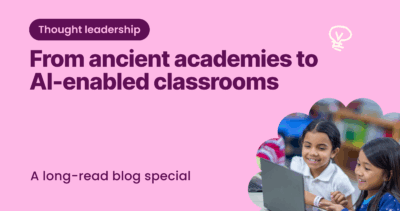
Shirin Bradfield
Traditionally, creativity doesn’t get prioritized in the long list of what teachers have to cover over the school year. Typically, it’s lumped together with other soft skills like communication and collaboration: Great in principle, but not as important as reading or math. However, recent studies are showing that being creative helps students learn better and is an intrinsic life skill that develops lots of other skill areas. As you may already have read creating a classroom environment that engages students in line with their interests will lead to better academic outcomes. Fostering creativity in the classroom is a sure way to engage students and improve their learning experience and create more engaged and confident learners.
What is creativity in the classroom?
If you flash back in your head to an old-school classroom, what do you picture? Wooden desks? a teacher at the front of the room dictating notes that students should write down? Notepads with the same uniform text children have noted down with zero personal flair? Think repetition, memorization, and a strong focus on reading and writing. Well, creativity in the classroom is the opposite of that! Creativity in the classroom is creating a learning environment that will help students learn problem-solving skills through projects or experiments. Creative thinking through team building exercises, and fostering creativity with an open and accepting classroom. I can already feel how much more the kids are enjoying learning than that flashback scene!
Why is creativity in the classroom important?
- Engagement and motivation to learn A study found that being creative is linked to being able to learn in the classroom. This study found that drawing is better than writing notes, viewing images, and listening to lectures.
- Inspires cognitive and critical thinking development If you frequently set work that involves creativity learners are more likely to develop higher-order cognitive skills — problem-solving, critical thinking, and making connections between their different subjects.
- Spurs emotional development Learning through problem-solving, risk-taking, and using critical thinking skills are all developed through trying, and sometimes failing. Allowing students to go on a learning journey, whether that ends with success or failure, is good for their development and educational results.
- Reaches all students You may have some students that really struggle to achieve academically. Sometimes creative tasks can be just the thing to reach those students that struggle in a more formulaic learning environment. It could really encourage students like this to enjoy the creative process and the creative classroom.
- Teaches professional development In 2019 LinkedIn found that creativity topped the list of in-demand skills in the workplace. In the 21st century, creativity and critical thinking are the integral skills that companies are looking for, alongside the other more traditionally valued traits, today’s students must learn these skills to be able to enter the workplace equipped. Young people need to concentrate on fostering their own creativity as much as other soft skills.
How do you bring creativity into the classroom?
When designing learning experiences and teaching creativity, teachers can develop lesson plans that give learners options, voice, and choice in how they choose to learn. Here are four things that teachers can do to foster creativity.
1. Plan lessons that facilitate creative learning that is aligned with students’ interests. Classroom example: A kindergarten class could create a new illustrated book each week that celebrates a different member of the class. Each book is full of pages drawn by each student. They have full freedom to describe what the person likes and how they perceive them.
2. Celebrate and reward creativity. Classroom example: Third-grade students are learning about geometric shapes and to see if they understand, you can ask the students to draw the shapes you’re learning about.
Once the students have finished this, you can tell the students to transform those shapes into something they love. The students want to show everyone their geometric-based kittens, robots, and dragons and then have an opportunity to explain to the whole class why they liked them.
3. Teach learners the other skills they need to be creative. Classroom example: A second-grade class is learning about the concept of freezing. You can ask one question to get them started, “Does only water freeze?” The kids then design an experiment to find out what other things might freeze and what things are not impacted by low temperates. The limit is that they can only use what they have available right now.
The students can come up with a list of things that they will try to freeze: perhaps water, juice, vinegar, glue, toothpaste, and paper. Some items they decide are already solids and shouldn’t go be frozen: pencils, erasers, and books. The next day, they can talk about what happened and why. (They will probably have engaging conversations about why the paper is stiff and the vinegar has not frozen!)
The brainstorming beforehand among students about what might freeze will help students work on skills such as articulating their own ideas and learning to adapt to other people’s ideas. The follow-up discussion encourages critical thinking and active listening.
4. Make a creative classroom. Classroom example: A sixth-grade class produces Halloween costume plays. In order to wear costumes to school, the students have to write a play that includes every character in the play. It will take some creative ideas to think about how a giant soda can and the superhero Wonder Woman could interact in the play. The students love the challenge and will have an intrinsic motivation to work on this.
We learn by doing
So let’s do it! Imagination and creativity are the traits that fuel the future. Both serve to inspire students and should be integrated into every part of learning. In planning and designing learning for students, we know: Teaching students how to think is more important than teaching students what to think.
You may also like

From ancient academies to AI-enabled classrooms

Improving AI literacy in American schools

